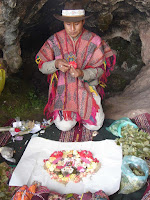The Shipibo are a tribe from the Amazonian rainforest in Peru credited with holding the traditions of the powerful entheogenic brew ayahuasca ("vine of souls"). This ancient tribe is known both for their beautiful geometric textiles and for their long history of using ayahuasca as an entheogen. This plant sacrament induces visual and auditory stimulation for the purpose of self-revelation and healing. In the Shipibo culture, shamans -- called curanderos -- work as plant-based healers of physical, mental, emotional and spiritual disorders. Their knowledge and healing power are said to come from the plants themselves.
Shipibo shamans have a custom in which a they live for months in isolation and ingest different plants in order to connect with the spirits of the plants. According to Shipibo shamanism, each plant has a different personality, just like people. Once a plant is ingested, the shaman may be inspired to write a song. These songs, known as icaros, are then used in healing ceremonies, and eventually translated into geometric patterns in order to adorn tapestries with their messages. Each song and corresponding pattern embody the energy of a specific Amazonian plant. The colorful designs are a woven visualization of each plant's song, almost serving as a musical score.
Shipibo textiles reflect the tribe's culture and cosmology. Largely geometric in nature, the designs feature the square, the rhombus, the octagon and the cross, which represents the southern Cross constellation. Other symbols featured in the designs are the Cosmic Serpent, the Anaconda and various plant forms, notably the caapi vine used in the preparation of the ayahuasca brew. Shipibo patterns are believed to heal physical, mental, emotional and spiritual ailments, with each design carrying its own meaning. Some are said to bring wisdom or protection; others attract abundance. The textiles are worn as skirts, placed on tables or beds, hung on walls or used in ceremony.
There is an fascinating connection between the visual and aural in Shipibo art: the Shipibo can paint the pattern by listening to an icaro, or they can inversely hear the song by simply viewing the design. Shipibo shamans, under the influence of the psychedelic affects of ayahuasca, undergo a sort of biological feedback mechanism which affects the visual cortex, allowing the music to be seen, and then translated into artwork. Known as synesthesia, this is a perceptual phenomenon in which stimulation of one sensory or cognitive pathway leads to involuntary experiences in a second sensory or cognitive pathway, in this case seeing by hearing, or hearing by seeing.
After discovering cymatics, the scientific study of geometric patterns created by sound vibrations, Irish artist Tanya Harris traveled to Peru in 2014 to explore the "visual music" of Shipibo art. Harris discovered cymatics while studying for an MA in Textile Futures at Central Saint Martins in London. Harris spent a month with the Shipibo and participated in ayahuasca ceremonies. During one of her last ceremonies, she received insight from ayahuasca that she should ask a shaman if she could record her singing a particular song and also get from her the geometric tapestry translation of the song.
So, using a handy video recorder, Harris carefully recorded the shaman's icaro about a plant called marosa. Harris found striking visual similarities between the shapes created by her cymatic patterns and the designs created by the Shipibo as illustrations of their songs. For Harris, it was simply confirmation that "sound is a primordial, creative force." Her experiences with the Shipibo are described in this short video, Consciousness Resides in Geometry.





